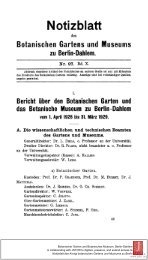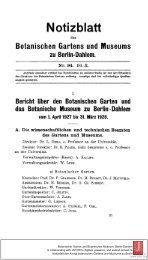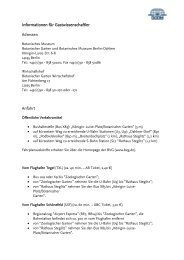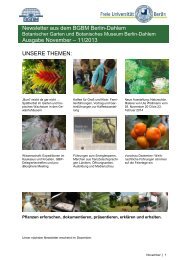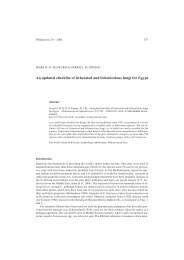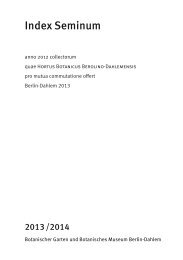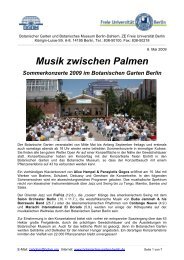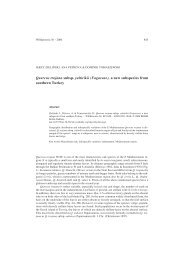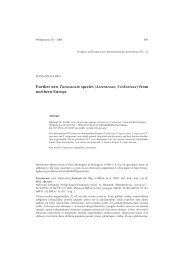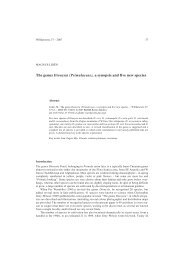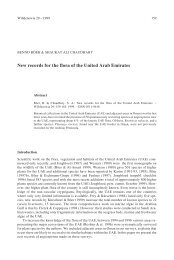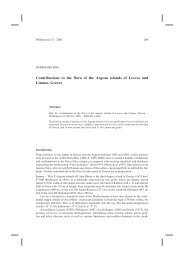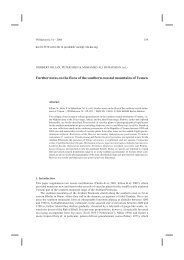Ausstellungskatalog - Botanischer Garten und Botanisches Museum ...
Ausstellungskatalog - Botanischer Garten und Botanisches Museum ...
Ausstellungskatalog - Botanischer Garten und Botanisches Museum ...
Sie wollen auch ein ePaper? Erhöhen Sie die Reichweite Ihrer Titel.
YUMPU macht aus Druck-PDFs automatisch weboptimierte ePaper, die Google liebt.
Präsentieren <strong>und</strong> Erklären 1910 – 2010 · Presenting and Explaining 1910 – 2010<br />
First Delight, then Instruct*: Visit to Dahlem, 1950 – 2010<br />
It would take almost 20 years before the traces of the Second World<br />
War had been entirely erased from the garden. The core of the Botanic<br />
Garden in Dahlem retained its former appearance, but there<br />
was considerable change in the peripheral areas. A first step towards<br />
ensuring the future of teaching was the reconstruction of<br />
the systematic section in 1947. Alongside the scientific mission,<br />
however, a new role was willingly embraced: through the insular<br />
position of West Berlin the garden had become a site of recreation<br />
and edification for the local population and thus had a different<br />
social function to fulfil from that of the pre-war period. 400,000<br />
visitors and 1000 school classes with a total of 25,000 pupils were<br />
the proud statistic of 1953, and one that changed little up to the<br />
fall of the Wall. The museum, which reopened in May 1963 after<br />
a longer period of rebuilding, could be visited daily apart from<br />
Mondays.<br />
As a post-war newspaper report announced, ‘It is springtime in<br />
Berlin when guided tours begin in the Botanic Garden’, and in<br />
order to make the month of March yet more alluring thousands of<br />
crocus and narcissi bulbs were planted on the great meadows in the<br />
garden from 1961 onwards. Once the Great Tropical House was<br />
reopened in 1968, a visit to it formed part of the Christmas holiday<br />
programme in Berlin and was recommended in city guidebooks<br />
Sonntagsspaziergang im Botanischen <strong>Garten</strong> um 1960. Postkarte. Heimatverein<br />
Steglitz e.V.<br />
Malkurs im Botanischen <strong>Garten</strong> 1994. BGBM, Archiv.<br />
139<br />
as a remedy against winter depression.<br />
From 1976 attention began to be drawn to particularly noteworthy<br />
plants by means of red dots. The garden’s educational programme<br />
expanded in 1978, at first through the employment of<br />
freelancers who offered additional guided tours on the most diverse<br />
topics. In 1983 an aroma and touch garden was opened with the<br />
principal aim of allowing blind and partially sighted visitors to<br />
experience the world of plants. In 1988 the ‘Botanikschule’ was<br />
fo<strong>und</strong>ed, an educational information centre which is still operating<br />
successfully to this day. Finally, in 1996, a new, more publicpleasing<br />
physic garden was opened with 230 labelled medicinal<br />
plants. Engler’s recreations of natural landscapes both in the open<br />
and in the glasshouses remain favourite visitor attractions, but<br />
increasing attempts have been made since 1990 to access new<br />
audiences with all manner of activities and events. The garden’s<br />
educational work today concentrates more and more on making<br />
visitors aware of the vital importance of plant diversity and how it<br />
is being threatened through climate change and man’s exploitation<br />
of nature. MH<br />
* ‘First Delight, then Instruct’ was the phrase used by Karl Friedrich<br />
Schinkel in 1828 when conveying to Wilhelm and Alexander<br />
von Humboldt the functions of a museum.



